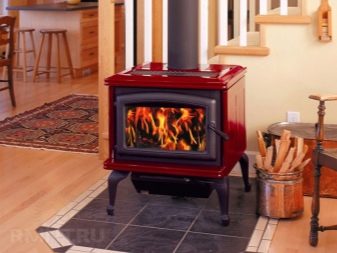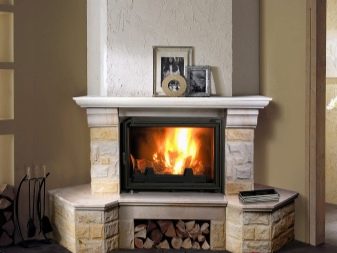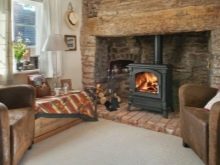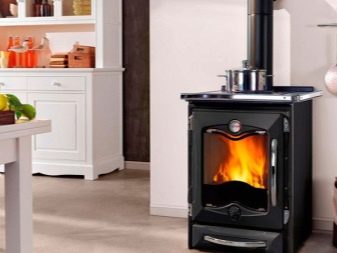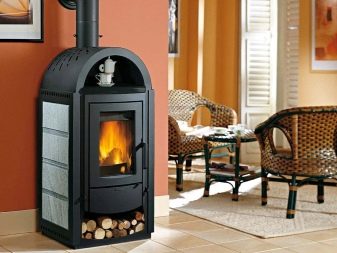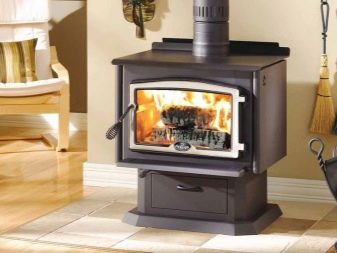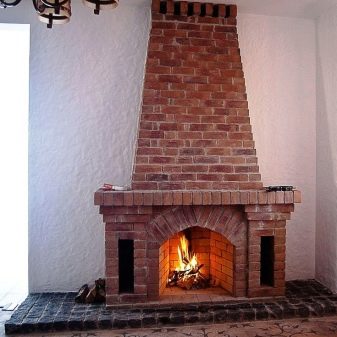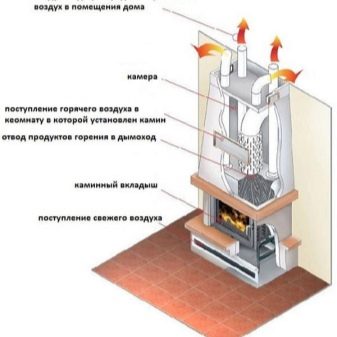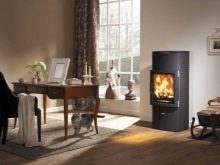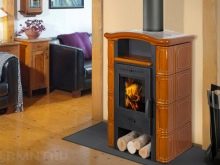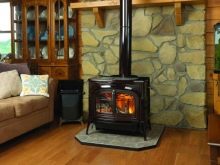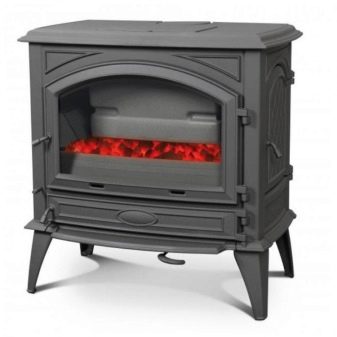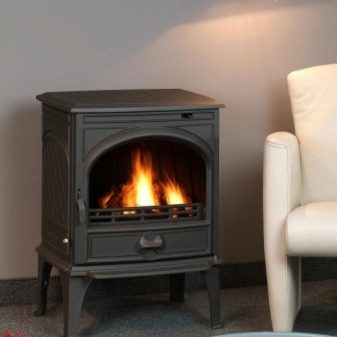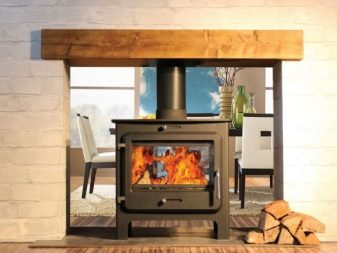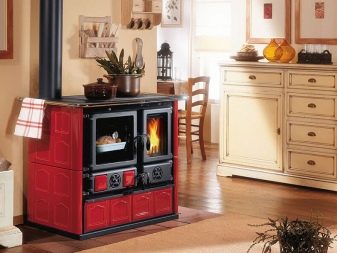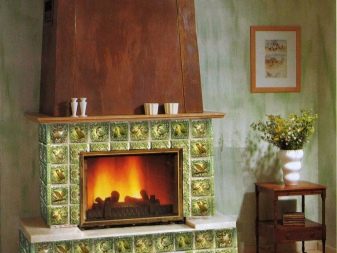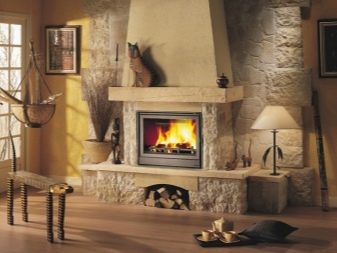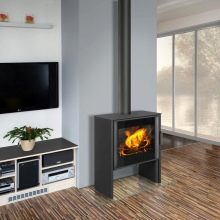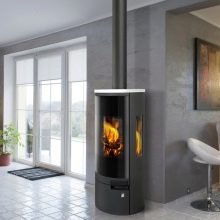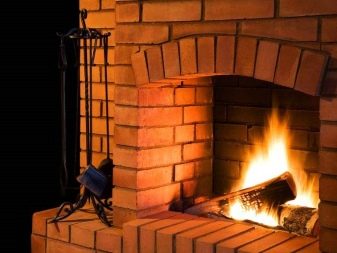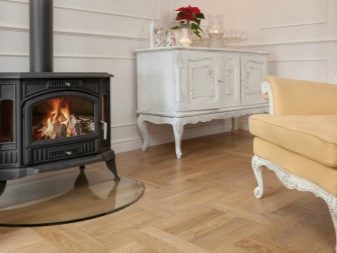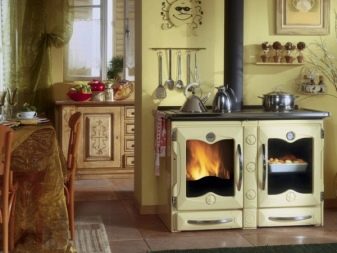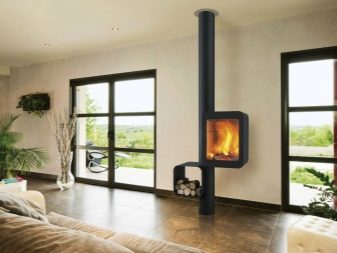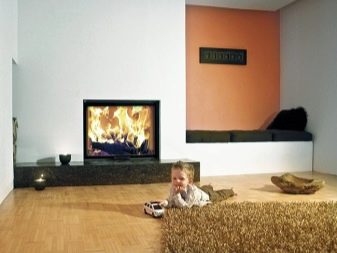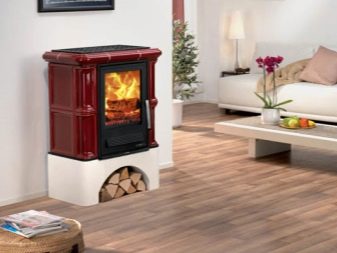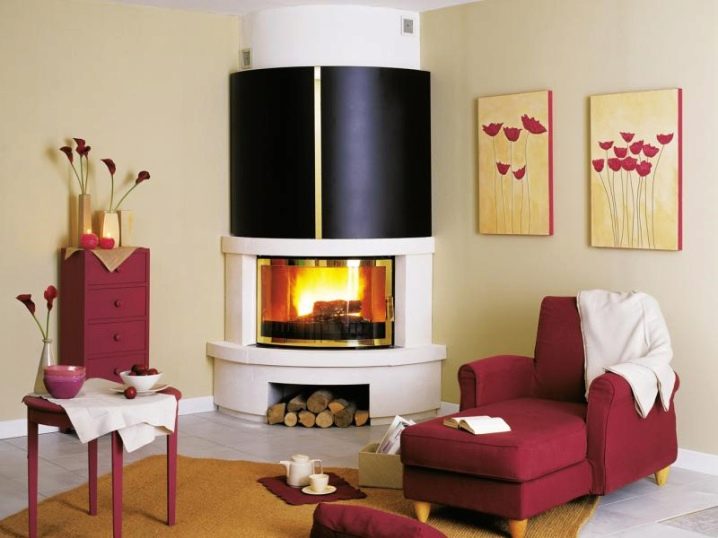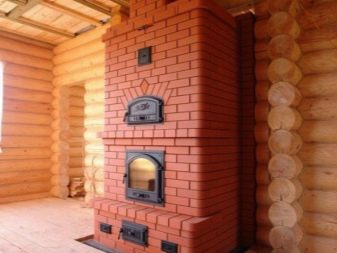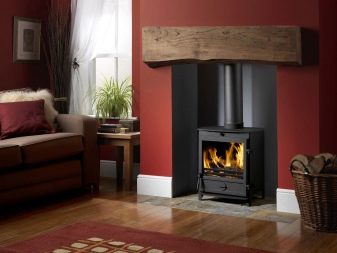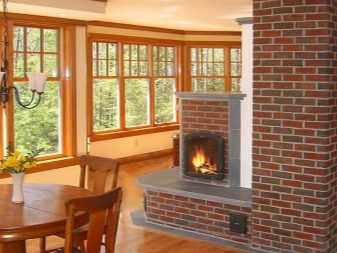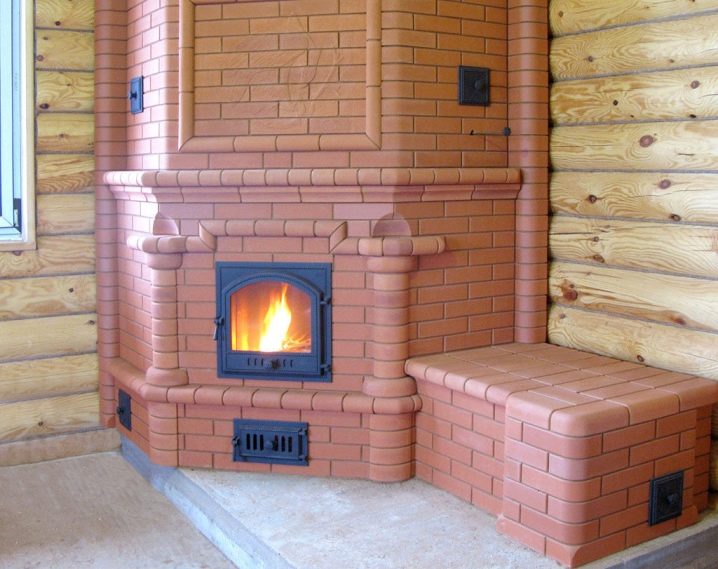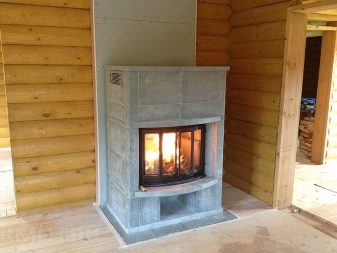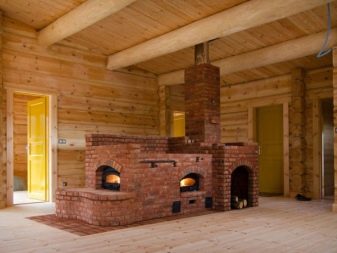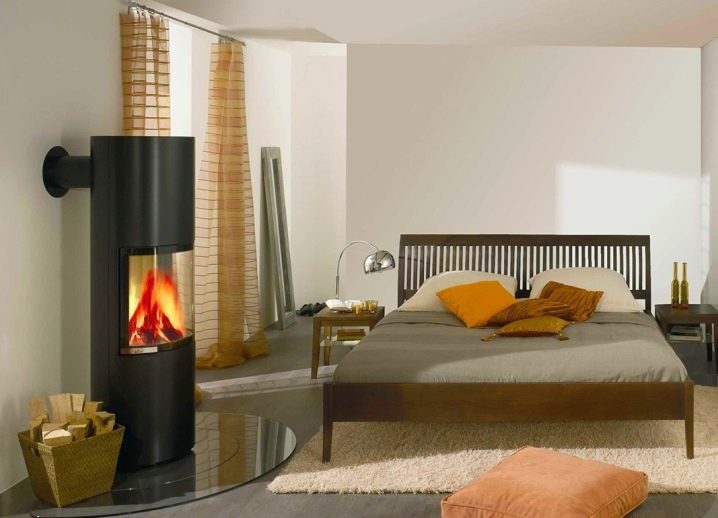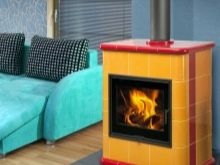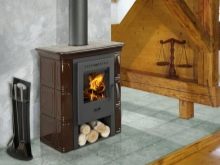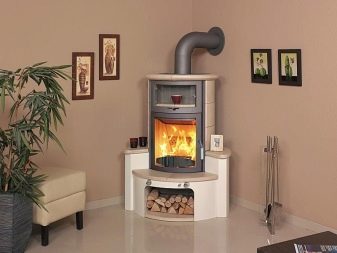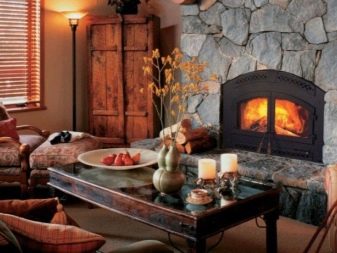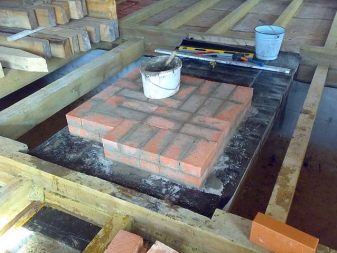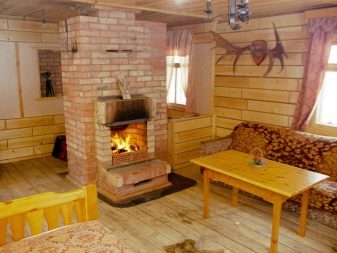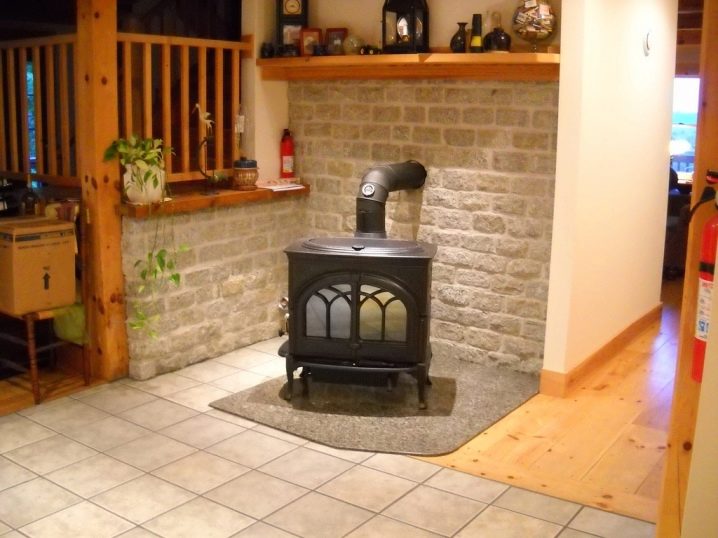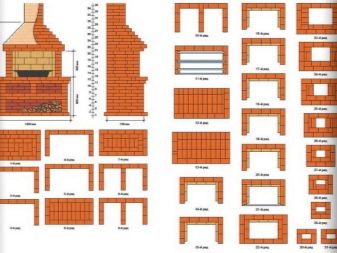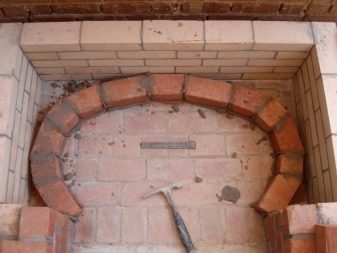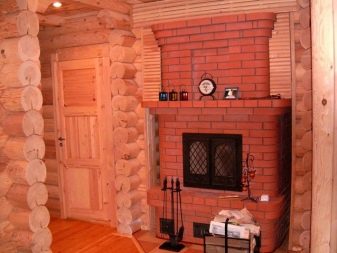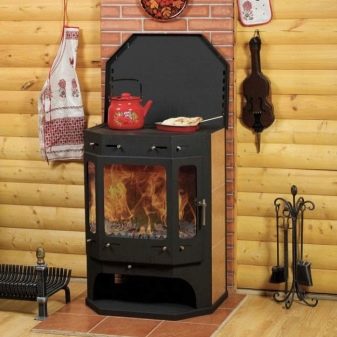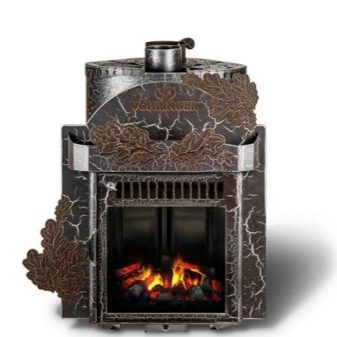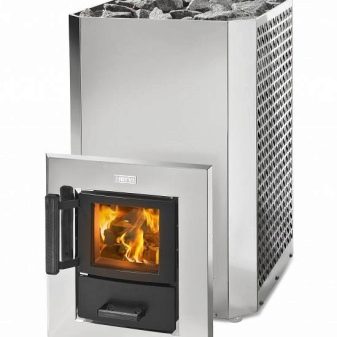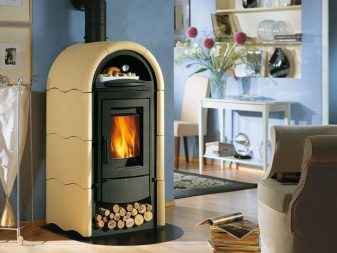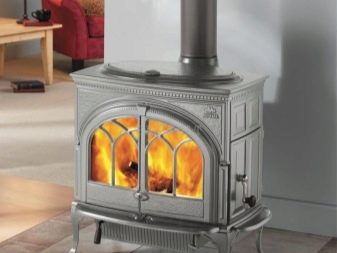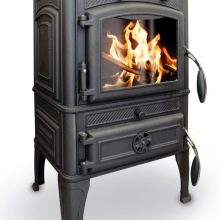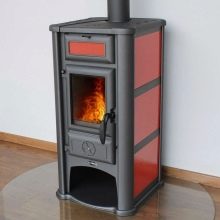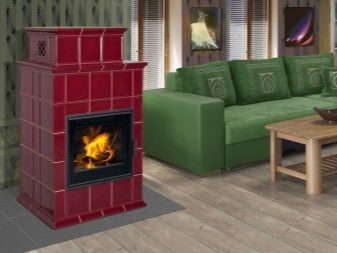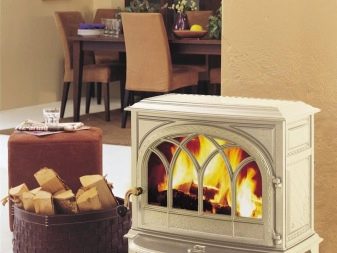Wood fireplaces for summer cottage: types, sizes and shapes
Very many people want to have a private house or cottage, and this is completely understandable: nature, garden beds, greenery, and garden are attributes of the life that attracts. Naturally, the issue of heating in country houses rises almost simultaneously with the acquisition or construction of this same house. After all, it should be warm, and it is desirable that it warms up quickly. Taking into account the extremely unstable electricity supply in the cottage villages, it is better to install an autonomous device for heating the house. And if at the same time it will be possible to enjoy the game of live flame languages, it will be wonderful. Fireplace stoves from wood combine all these requirements.
Features and benefits
The stove combines the best and most sought-after properties of several devices for heating, in particular, as the name implies, stove and fireplace advantages.
What does it mean? Ordinary fireplaces working on wood are inefficient, they have a low efficiency, and all this is due to the fact that the overwhelming part of the heat in the literal sense of the word "flies into the chimney." That is why they are used as interior decoration, less often - as a source of heating. Of course, it cannot be denied that the flame dancing in the hearth is a very attractive sight, adding comfort to the house. As for wood stoves, they are more efficient and can be used as the main source of heating. However, their appearance and design is unaesthetic and unattractive.
A wood burning stove combines the aesthetic appeal of the fireplace with the efficiency of the heating properties of the stove. This is a factory product installed directly on the floor. Either bent sheet steel or cast iron is used for its manufacture. The design resembles a sauna stove, but it has no stone compartment. Facing can be very different, respectively, it is possible to choose a stove for any style of interior.
Fireplace stoves, working on wood, act like a heater.Coolant - air that rises up when heated, respectively, the cold air masses go down. This is the so-called cluster oven devices. This kind of convection does not always work naturally; in some models, forced automatics are used to regulate the intensity of fire burning.
In long-burning systems, after ignition occurs, oxygen supply ceases there, and firewood continues to smolder in the afterburner. Thus, it is possible to achieve uniform heat release up to 8 hours in a row.
The advantages of a wood fireplace over a gas are several:
- they are cheaper;
- more environmentally friendly;
- less money will be spent on fuel and its payment. Gas in this regard is not suitable, since the amount of utility bills can be very impressive.
According to the material from which they are made, wood burning fireplaces can be:
- metal (steel or cast iron);
- brick;
- combined in which the brick and metal are connected.
You can also divide them in accordance with the method of heating the room:
- by means of air convector heating;
- through the water circuit.
The most common furnaces are made of steel or cast iron with an impressive door for a firebox made of fire-resistant glass, allowing you to observe the fire. However, there are also brick constructions, in which a fireplace and a heating stove are connected with smoke. Also on the market are combined (hybrid) fireplace stoves of metal and brick, and they either look like a brick building and a metal firebox, or a furnace made of metal, lined with brick inside or trimmed with stone outside.
Speaking about the advantages of stoves, you need to say the following:
- the main thing is the use of environmentally friendly fuel;
- esthetically attractive appearance;
- they are easy to install;
- high efficiency;
- compactness, allowing to place them even in the smallest room;
- various cladding options will allow the stove to fit into any interior style;
- low cost of installation and installation of the chimney;
- durability and reliability of a design.
It’s not quite right to speak about the shortcomings as such; after all, in their group, stoves have no competitors. Therefore, it is better to call it conditional minuses:
- uneven distribution of heat in the room - the higher, the warmer;
- inability to keep the air in the room warm for a long time;
- small thermal capacity - cooling occurs almost immediately after the furnace stops;
- charcoal firebox is impossible, only dry firewood. Coal can damage the furnace parts. In addition, the room needs a place to place firewood;
- the more high-tech the furnace, the more expensive it is;
- efficient heating is possible only in the room where the fireplace is located, if the model does not have a water circuit.
If there is no water circuit, it is better to consider combining a furnace device, for example, with an electric convector.
Kinds
Most of the models on the market of stoves, belong to the models of long-burning. Basically, they all work on wood, but there are also those that can heat the room by burning coal. Coal-fired Kaminopech is very economical, because coal needs to be laid only once in 24 hours.
Metal fireplace stoves most often made of steel or cast iron.Their furnace door is quite large, the material for it is glass-ceramic or fire-resistant glass. This type of fireplace stoves heat the room by radiating heat and convection of air (a cassette-type firebox), and if the stove device is connected to a water-heating system, it is also connected with a water circuit. And it is a stove device with a water circuit that is best suited if it is the main source of heating, because then you can warm up several rooms at once or completely the whole house.
The contour type is ideal for a house in which they live constantly, all year round, it has the best heating properties. For giving, on which happen arrivals, there is nothing more convenient than the furnace fireplace with air heating.
The chimney at the metal furnace devices can go up or be located behind. The second variation is the most aesthetic, besides it allows you to connect the device to the chimney in the wall.
The cast-iron construction is more resistant to the damaging effects of the environment and more inert, however, it can easily suffer from mechanical shock. In addition, due to the fact that it has thicker walls, it is much heavier than steel.
In some cases, make the lining, that is, the calculation of the firebox of the fireplace-furnace inside a fire-resistant brick or tiles made from this brick. Then there is an increase in the resource and inertia of the furnace: it will heat up longer, but the heat will also be stored for a longer time. For the same purpose (heat preservation), the stoves fireplaces of metal are trimmed outside with a tile or natural stone.
The advantages of metal fireplace-stoves are the following:
- relatively compact size, i.e. they are suitable for use in small homes;
- they are mobile, portable - they can be moved to another room, subject to availability of possibility to connect to the chimney;
- a wide selection of different types of design;
- they are economical, since most models have not only the main combustion chamber, but also an additional one, where the afterburning takes place, this increases the efficiency of the fireplace-stove;
- Some models can be connected to the water heating system.
In addition to metal stoves, they can also be used brick options. The device is such that in the case they install both a fireplace hearth with a straight chimney and a furnace with smoke turns.Such constructions are fueled in turns, the valves overlap one or the other part of the stove. As a rule, these devices are used in winter as heating stoves, and in other seasons simply as a fireplace.
The brick construction heats up much slower than the metal one, but it also cools down more slowly. Their device provides the opportunity to accommodate a water heating exchanger, then it will heat several rooms. For the construction of a brick fireplace stove a foundation is required.
Combined fireplace-stoves differently called embedded. The base of such a device is a metal fire chamber, open or closed by a door of refractory glass. This furnace is built into a brick building, which is laid out so that the air has access to the external surface of the furnace, and convector is used as a way to heat the air.
It is also possible to connect a combined convector device to a hot-water heating system, then its design must initially be with a heat exchanger. Such stove devices need to build a foundation, and also take up quite a lot of space.
Also in the design of the stove can be provided such functions as:
- water circuit;
- cooking surface.
If the firebox at the fireplace is open, the air is heated rather quickly. And if this stove device is equipped with a hob, then you can cook food on it. A fireplace-barbecue will allow you to enjoy grilled meat whenever you wish. And you can even put a brazier near the stove.
There is another classification of fireplace rooms - by location:
- central;
- facial;
- arbitrary;
- angular - symmetrical and no.
You can also divide them into:
- built-in - they are mounted immediately when building a house;
- wall - located along a windowless wall.
The most frequently encountered is a wall fireplace-stove, its rear wall is installed close to the wall of the house. It can be any size - from compact to huge; different shapes - from direct to protruding. Often it is decorated with a portal, it adds elegance and originality to the interior.
Corner fireplace stoves can be mounted in two ways:
- on two sides of the outer corner;
- at one angle diagonal through two walls.
The first type of installation is good in a room with a large area and original features of the layout. The second takes up very little space and will successfully rise everywhere, even in the smallest room.
Constructions
As for metal fireplaces-stoves, all of them have the so-called potbelly stove in their prototype and are improving at its base. Brick oven devices are more multivariate. The four most common types are Russian, Dutch, Swedish, and Finnish. There are also fireplace stoves that bear the names of their creators, for example, the Kuznetsov stove.
Materials
If we talk briefly about the materials for making fireplace stoves, then brick structures are more expensive, heavier and take up more space, while cooling down longer; metal (made of iron, steel, iron) is more compact, cheaper, more mobile, but they need to be constantly heated, they quickly cool.
The merits and drawbacks of a separate brick construction and a separate metal construction were mentioned in detail, let us dwell on combined kiln devices that combine a cast iron or steel body with a brick finish. Or vice versa - iron construction inside lined with refractory bricks.They also have a number of advantages:
- Combined fireplace stoves allow you to quickly warm up - immediately after the firebox began, it becomes warm.
- Their efficiency is higher than that of brick counterparts. Best of all are those kilns in which a long burning system is installed.
- There is automation to regulate calorific value. For brick fireplace, this is still a story from the realm of fantasy.
- They are much safer than buildings with an open hearth.
- There are models equipped with burners, water tanks.
- Do not use water as a heat transfer fluid.
- Not related to power supply, respectively, do not depend on it.
- Ergonomic and small constructions. Very wide range.
- You can put on the floor without a foundation.
Dimensions
The size of the stove depends primarily on the material from which it is made. If we talk about the brick structure, the word "small" does not fit it. The same can be said about the combined stove-fireplace - the most compact of them weigh at least 80 kg.
However, there are also mini-fireplaces.They are made of cast iron or steel and are available for cladding of various kinds of materials, such as ceramics, majolica or natural stone.
How to choose?
An inexperienced buyer may become entangled in the choice of a fireplace-stove for heating a country house, because there is a huge amount of heating devices for sale. To avoid mistakes when purchasing a stove, you need to analyze the assortment on the market, as well as determine the model that is suitable in all respects.
For example, a wood-burning stove made of cast iron is simply made for a home in which long-term heat retention is needed.
In order for the furnace device to fit perfectly into the interior of a small cottage or a country house, you need to correctly calculate a number of parameters:
- The size and power of the furnace. The larger the room that needs to be heated, the higher should be both indicators. If you try to cheat and save - the oven device will overheat and break.
- The efficiency of the device. The higher the rate, the less fuel will be consumed and overrun. Less than 60% is unacceptable.
- For different model ranges of furnace devices, fuel types differ.Before you buy, be sure to clarify which type is used in the vending model: coal, wood or peat in briquettes.
- The rate of heating of the air in the room depends on what the stove is faced with. It is best to keep the heat of the furnace with a ceramic or stone body, but we must remember that they warm up longer.
- The construction of the chimney depends on the diameter of the pipe: if the chimney is narrow, all the fumes will go inside the room. It must be remembered that for 1 kilowatt of power you need 8 cm2 section.
In addition, when purchasing a furnace device, it makes sense to listen to the following recommendations:
- It is necessary to place the stove device at a safe distance from easily burning objects. This can be from 20 cm to 1 m. The instruction manual should indicate the recommended distance.
- It is necessary to calculate the diameter of the chimney. If there is no chimney, you must buy it.
- A steel floor plate should be placed in front of the stove. This is necessary so that the sparks emanating from the fireplace do not spoil the floor covering and do not provoke a fire.
- It is better to purchase models in which you can replace refractory bricks or cast iron plates in the firebox.
- Before buying, be sure to check how well the device is completed: whether the glass door fits tightly to the hole in the firebox, whether there are leaks around the perimeter of the fit, whether the case and internal compartments are deformed, whether there is thermal insulation on the adjustment knobs and the handle and whether they open and close freely moving parts.
- Included with the device should go all the required certificates. We are talking about fire, manufacturer's certificate and hygienic conclusion.
- You also need to make sure that the product has a warranty, and clarify which cases are guaranteed and where it is fixed.
How to do it yourself?
If you decide to create a stove yourself, you need to decide on the material from which the work will be done.
Heat-resistant brick requires a clear definition of the place where it will be, as the furnace device from it must be placed on the foundation. It is better, of course, to determine the location before building a house, then the foundation can be laid immediately.
If the house is built before any thoughts about installing a fireplace-stove, you can build it into a finished building.However, one must be prepared to dismantle parts of the roof and floor.
You should listen to a number of recommendations for installation:
- The construction will be massive and heavy. The lightest and smallest brick-burning stove weighs more than 600 kg. Therefore, it is very important to lay a reliable foundation for it.
- It takes a lot of space for a fireplace.
It is necessary to begin construction of the fireplace stove from the bottom about a meter deep. At the bottom of the dug pit laid out laying for waterproofing - roofing material, folded in half. For fixing masonry used clay solution. Brick must be pre-soaked. Otherwise, he will take water from the mud. How horrible bricks do not put. The order is carried out in accordance with the design and type of design chosen: angular, built-in, wall chimney oven.
If it is planned to build a fireplace stove out of metal, then the sample should be taken from a stove known to everyone and everyone. Such a device will easily fit into the style of a country house.
The chimney can be installed both outside the house and inside it. With self-assembly, it is imperative to pay attention to ensuring that the chimney is fireproof.
The chimney installed indoors is better. Since it is in an upright position, soot settles less on its walls. In addition, it produces less condensate. If the chimney is placed outside, then a metal pipe will stick out along the wall. There will be more condensation and traction will clog more often. In addition, in the winter time the pipe will cool faster.
Step-by-step plan for installing a brick stove:
- Drawing up a drawing.
- Preparation of necessary materials and tools. The number of bricks, for example, depends on what kind of space you need to heat.
- Pouring the foundation. This is done with the help of concrete in a ratio of 1: 3: 1 (one piece of sand and cement, three parts of gravel). Next is reinforcement, used for this masonry mesh. After that - digging asbestos piles with a length of 1 meter. They need to dig at least five. At the end of the casting, the base must be at least 3 rows of brickwork below the floor level.
- It is much better to lay out each row dry, without solution, before the laying. This is done even by experienced stove-makers. First, it will allow to determine the exact number of bricks in the rows, and secondly, specify the layout.
- The first row needs to be laid out very smoothly, because it is thanks to him that the direction of the walls of the structure is given. In the second row, air ducts, a fireplace insert and a blowing chamber are already visible.
- Rows 1-20 are laid using silicate white brick, then use red fire-resistant. The display should be made in strict accordance with the scheme. Control of the horizontal and vertical is carried out using a plumb line and level. There should be no gaps or gaps. Especially carefully you need to lay out the chimney, in the place where it passes through the ceiling, insulation should be laid.
- As soon as the construction of the fireplace stove body is completed, it is necessary to install a heat exchanger (water heater) in the stumbler, as well as a fire-resistant glass door.
- Now you need to go to the drying. For this, several small fireboxes are made. After the control furnace, you can proceed to the finish, if it was planned.
For information on how to lay a fireplace stove with a glass door, see the next video.
Brand Rating
Russia is represented on the market of stoves by the group "Meta" - one of the leading manufacturers.Products are collected in accordance with European industrial standards from high-quality components coming from abroad. All manufactured models are subject to rigorous multi-stage control. Product quality is constantly improving. The model range is very extensive, which will allow you to choose the right option for everyone.
Russian stoves and fireplaces are also manufactured by Ecosofef under the brand name “Bavaria”. The equipment on which the production is carried out comes from Germany, the company has been operating since 2007. Ekostof stoves and fireplaces are ideal for heating cottages - places where they do not live on a permanent basis. Models "Bavaria" are quite powerful, well heated and economical use of firewood. The efficiency of furnace devices is on average 78%. It is important that the combustion chamber in Ecosof models is easy to clean.
Another domestic manufacturer - "Feringer". The model range of the company is modern and does not lose relevance, although it is small. The advantage is the low cost of production, as well as the presence of a cooking surface.
One of the most honored manufacturers in the market - the company Narvi. She has been manufacturing equipment for saunas and baths since 1936. Some devices in their model range have no analogues among the products of other firms. Design and production is concentrated in Finland. The experience gained over decades allows us to sharpen the smallest nuances in the manufacture of our products every year.
Norwegian manufacturer Jotul specializes in the production of stoves and cast iron fireplaces. The quality and safety of the company's products is above all praise. In addition, the range is presented as a traditional stove devices, and design. Jotul has been on the market for more than 150 years, the company's reputation is impeccable. Any interior will benefit if you add a Jotul fireplace as part of it.
Another one of the leading manufacturers of products for heating - the Italian company La Nordica. The company is constantly expanding the range and improving the production process. The choice of products that La Nordica offers to the consumer is truly enormous - from the colors to the models.
Serbian manufacturer Guca - number one on the market of their country. In the global market also occupies a leading position.The relentless improvement in production is the way Guca achieved this. A large amount of funds the company spends on carrying out technological research, which allows to improve the quality of manufactured products. The efficiency of Guca models reaches 84%. Consumer reviews about the products of the company are only positive.
Another Serbian manufacturer - Tim Sistem. Specialization - ovens and stoves. The company's models are environmentally friendly and economical. As for the Koper furnaces, their manufacturer focuses on improving the secondary afterburner system. This increases the efficiency of the furnaces up to 78%. Afterburning of flue gases helps burning to be clean, reduces the emission of soot. Thus, the cost of maintaining the chimney is reduced, and the service life of the device increases.
Beautiful interiors
- The semi-antique stove with a chimney-column looks very stylish.
- Metal stove with a hob - functional and beautiful.
- A lined stove perfectly complements the interior.
- Pig-iron construction does not look very heavy.


